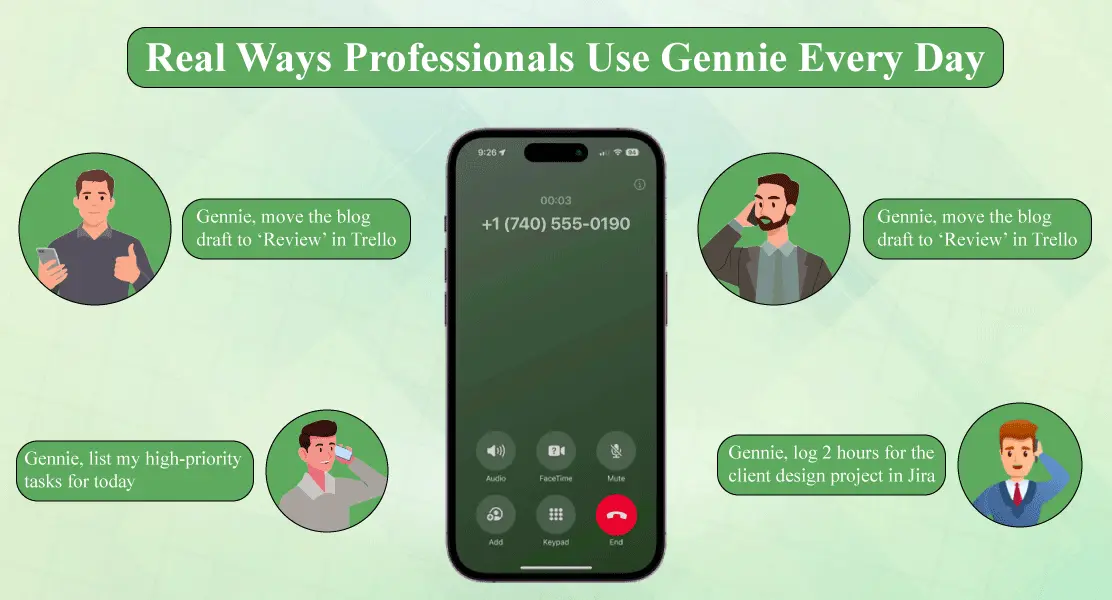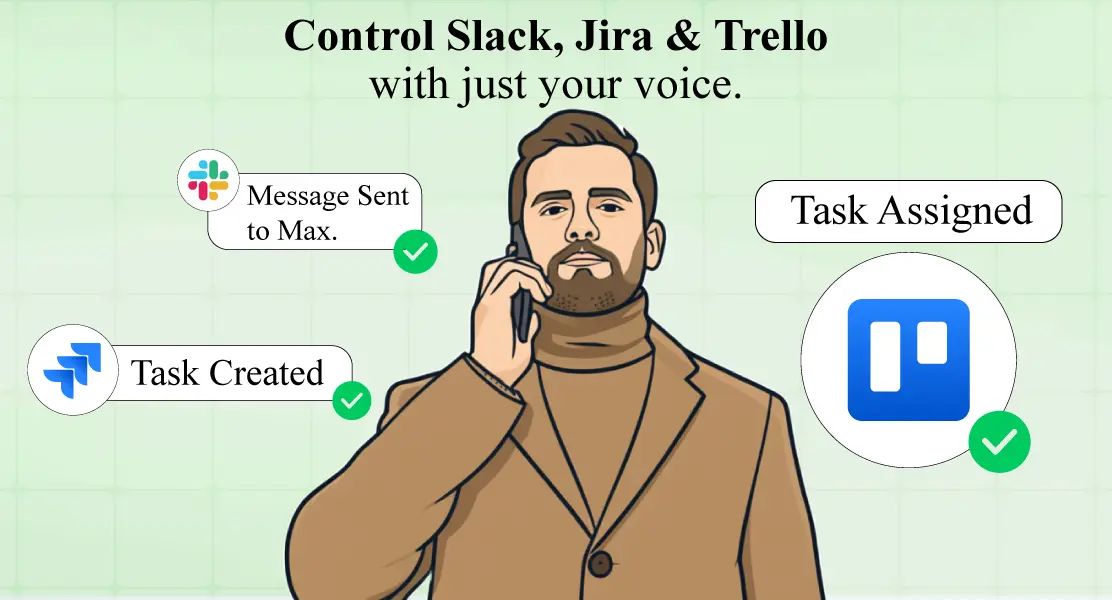Modern teams rely on Asana to manage tasks, deadlines, and project workflows. Yet even with powerful features, the tool demands constant manual input, including typing updates, changing due dates, assigning tasks, and maintaining momentum—the friction compounds during busy schedules, field operations, client calls, and leadership reviews. Today’s work environment demands speed, clarity, and hands-free control.
This is precisely where the ability to manage Asana projects with voice becomes a game-changer. With call-driven automation, project updates no longer require screens or keyboards. Teams can stay aligned with just a quick voice command. Gennie brings this future to the present by embedding AI-driven voice automation into daily project workflows. Through Gennie Asana integration, teams can run Asana operations naturally through simple phone conversations, providing a fast, intuitive, and fully synced experience within your workspace.
Gennie continues to expand its hands-free productivity experience across its entire platform, enabling teams to manage work from anywhere. For teams seeking enhanced engagement, agility, and speed, voice-driven execution represents one of the most significant workflow upgrades available today.
Where Voice Automation Fits Into Modern Project Management
Manual updates slow decision-making during high-pressure situations. Managers might be on the move, attending client meetings, or coordinating across distributed teams. Leaders often juggle dozens of tasks simultaneously, and opening Asana every fifteen minutes to log minor updates adds up. A tool designed for clarity becomes challenging to maintain when you’re constantly switching contexts.
This is where voice-powered execution matters. With voice-controlled Asana tasks, teams can capture real-time information the moment it occurs, without interrupting the workflow. Whether someone is in the field, commuting, or rotating between meetings, they can simply call Gennie and update the project instantly. The ability to navigate tasks using natural speech makes the entire project stack responsive and accessible, regardless of platform or device.
The dedicated Asana Voice Agent acts as the bridge between these voice interactions and actionable project updates. It eliminates friction, reduces lag, and fosters a natural operational flow that aligns with human behavior rather than rigid systems.
How Gennie Enables Voice-Driven Asana Operations
Gennie does not simply convert speech to text; it interprets intent, context, and structure to provide accurate results. The system is trained to understand Asana voice commands and convert them into precise task operations. It supports a wide range of actions, including creating tasks, closing tasks, updating deadlines, assigning owners, adding descriptions, modifying priorities, and adjusting project sections.
Every action is triggered through AI call automation for tasks, where team members dial a dedicated Gennie number or platform-based calling interface. During the call, they can naturally express updates, and Gennie handles the rest.
A typical call might sound like this:
“Create a new task in ‘Product Roadmap’ called ‘Update UI components’ and assign it to Priya for Friday.”
Another example could be:
“Mark the task ‘Legal Checklist Review’ as completed and move it to the Done section.”
Gennie understands the phrasing, identifies the right task, confirms the intent, and executes the update inside Asana: no screens, no menus, no typing, just pure voice.
This precision comes from a combination of voice understanding, workflow mapping, and deep API-level connectivity. Through Gennie's voice automation, the system handles cross-project lookups, task matching, and project navigation while maintaining accuracy even with complex organizational structures. Leaders can steer entire pipelines through natural phone calls, dramatically simplifying oversight and execution.
Practical Use Cases That Transform Daily Workflows
Teams across industries are recognizing the advantage of voice-driven project updates. Asana is already known for its structured workflow, and combining it with voice input unlocks new layers of productivity.
1. Rapid Task Creation During Meetings
In fast-paced discussions, ideas and action items move quickly. Instead of switching tabs or noting them down for later, leaders can call Gennie immediately:
“Create a task ‘Prepare financial dashboard draft’ and assign it to the analytics team for Monday.”
This ensures that tasks are always captured in real-time.
2. Daily Standups Without Manual Logging
Remote teams often struggle to log stand-up updates consistently. Through voice, each team member can simply call in after completing their work, and Gennie updates the Asana board instantly. This creates effortless consistency and reduces administrative overhead.
3. Updating Task Status on the Move
For operations-focused teams, such as logistics, fieldwork, and deployment teams, manual updating is nearly impossible. Calling Gennie makes it seamless:
“Move ‘Site Visit Preparation’ to In Progress and update the due date to tomorrow.”
4. Managing Approvals Through Voice Calls
Approvers or department heads often delay updates when their dashboard is complete. Voice automation solves this easily:
“Approve the ‘Budget Planning Q4’ task and assign it to finance.”
5. Updating Project Boards Using Voice Commands
With updated project boards that utilize voice commands, teams can move tasks across sections, adjust priorities, or shift entire segments of work simply by issuing spoken instructions. This is particularly powerful for agile teams working in sprints.
These use cases reflect a broader shift in productivity thinking. When teams can operate their collaboration tools through natural speech, work becomes lighter, faster, and much more human. For more insights into this shift, particularly how AI influences everyday work, refer to the Gennie blog, which discusses how Gennie is redefining productivity.
Who Benefits Most From Voice-Driven Asana Management
Any organization that depends on quick decision-making, frequent task updating, or distributed operations can benefit. Executives who move between meetings, startup teams handling rapid iterations, and managers coordinating cross-functional efforts all gain significant time savings.
Operations teams receive even greater value. Their workflows involve constant environmental shifts, and with voice-driven updates, they no longer need to pause work just to update the system. Voice automation transforms Asana into a system that adapts to the realities of real-world work, rather than requiring constant manual intervention.
Even founders who often need to manage product, clients, hiring, finance, and sales simultaneously can streamline their entire workflow by offloading repetitive updates through Asana voice assistant functionality.
Why Voice Is Becoming the Next Project Management Standard
The rise of voice-based productivity tools is accelerating across industries because natural speech removes friction from digital operations. Voice input is faster than typing, more intuitive than navigating menus, and far more accessible for teams working in dynamic environments.
Where traditional automation tools require structured triggers, Gennie interprets conversational instructions. This makes automation flexible, user-friendly, and scalable. The combination of voice interfaces, AI-driven understanding, and seamless Asana integration is paving the way for a new operational ecosystem where work moves at the speed of conversation.
As voice AI continues to evolve, teams will soon be able to manage entire workflows from reporting to sprint planning purely through spoken instructions. Gennie is actively driving this transformation by building deeper voice understanding, smarter automation logic, and broader integration capabilities across leading productivity platforms.
Conclusion
The ability to manage Asana projects with voice is no longer a futuristic idea; it is now a practical, high-impact solution that eliminates friction, boosts productivity, and helps teams stay aligned effortlessly. Gennie extends Asana’s capabilities through real-time voice-driven workflows, where calls become the bridge between intention and execution.
By combining natural language understanding with powerful workflow intelligence, Gennie reduces administrative overhead, accelerates task creation, and enables rapid decision-making. Whether you lead a growing startup or manage a distributed team, the future of project management lies in voice-first automation, and Gennie is building the foundation for that future today.







